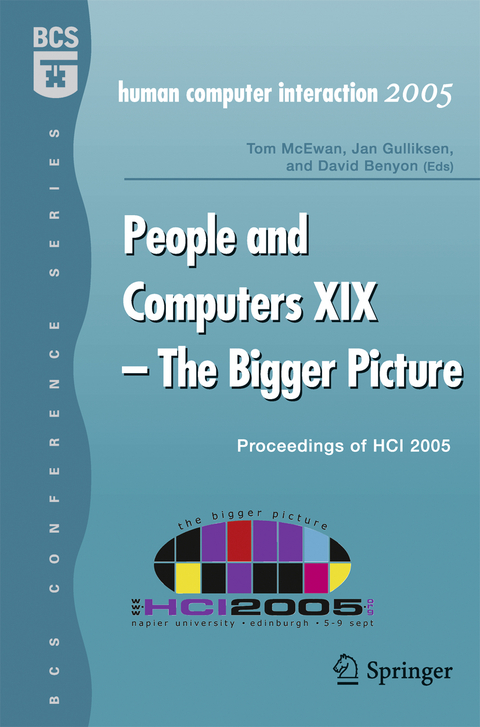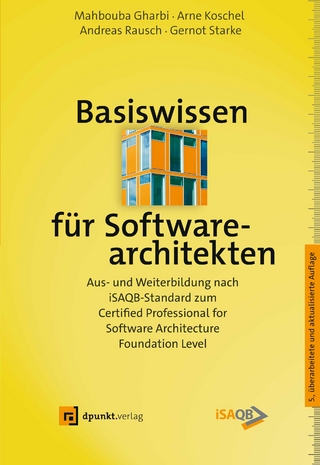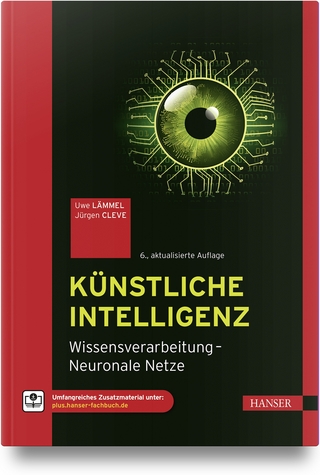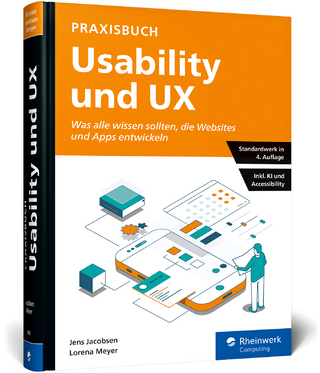
People and Computers XIX - The Bigger Picture
Springer London Ltd (Verlag)
978-1-84628-192-1 (ISBN)
H — HCI at the Human Scale.- “Looking At the Computer but Doing It On Land”: Children’s Interactions in a Tangible Programming Space.- The Usability of Digital Ink Technologies for Children and Teenagers.- PROTEUS: Artefact-driven Constructionist Assessment within Tablet PC-based Low-fidelity Prototyping.- The Reader Creates a Personal Meaning: A Comparative Study of Scenarios and Human-centred Stories.- What Difference Do Guidelines Make? An Observational Study of Online-questionnaire Design Guidelines Put to Practical Use.- Designing Interactive Systems in Context: From Prototype to Deployment.- Using Context Awareness to Enhance Visitor Engagement in a Gallery Space.- Engagement with an Interactive Museum Exhibit.- User Needs in e-Government: Conducting Policy Analysis with Models-on-the-Web.- Fit for Purpose Evaluation: The Case of a Public Information Kiosk for the Socially Disadvantaged.- A Visuo-Biometric Authentication Mechanism for Older Users.- C — HCI in the Greater Cultural Context.- A Computer Science HCI Course.- Use and Usefulness of HCI Methods: Results from an Exploratory Study among Nordic HCI Practitioners.- Building Usability in India: Reflections from the Indo-European Systems Usability Partnership.- Visualizing the Evolution of HCI.- “I thought it was terrible and everyone else loved it” — A New Perspective for Effective Recommender System Design.- Rich Media, Poor Judgement? A Study of Media Effects on Users’ Trust in Expertise.- Cultural Representations in Web Design: Differences in Emotions and Values.- Interaction Design for Countries with a Traditional Culture: A Comparative Study of Income Levels and Cultural Values.- Researching Culture and Usability — A Conceptual Model of Usability.- I — HCI Down at the Interface.-Distinguishing Vibrotactile Effects with Tactile Mouse and Trackball.- HyperGrid — Accessing Complex Information Spaces.- Mixed Interaction Space — Expanding the Interaction Space with Mobile Devices.- Static/Animated Diagrams and their Effect on Students Perceptions of Conceptual Understanding in Computer Aided Learning (CAL) Environments.- Media Co-authoring Practices in Responsive Physical Environments.- Cognitive Model Working Alongside the User.- Revisiting Web Design Guidelines by Exploring Users’ Expectations, Preferences and Visual Search Behaviour.- Comparing Automatic and Manual Zooming Methods for Acquiring Off-screen Targets.- Forward and Backward Speech Skimming with the Elastic Audio Slider.- Design Patterns for Auditory Displays.- Closing Keynote of HCI2005: The Bigger Picture.- Grand Challenges in HCI: the Quest for Theory-led Design.
| Erscheint lt. Verlag | 1.9.2005 |
|---|---|
| Zusatzinfo | 138 Illustrations, black and white; XVIII, 510 p. 138 illus. |
| Verlagsort | England |
| Sprache | englisch |
| Maße | 155 x 235 mm |
| Themenwelt | Mathematik / Informatik ► Informatik ► Betriebssysteme / Server |
| Mathematik / Informatik ► Informatik ► Datenbanken | |
| Informatik ► Software Entwicklung ► User Interfaces (HCI) | |
| Mathematik / Informatik ► Informatik ► Web / Internet | |
| ISBN-10 | 1-84628-192-X / 184628192X |
| ISBN-13 | 978-1-84628-192-1 / 9781846281921 |
| Zustand | Neuware |
| Informationen gemäß Produktsicherheitsverordnung (GPSR) | |
| Haben Sie eine Frage zum Produkt? |
aus dem Bereich


